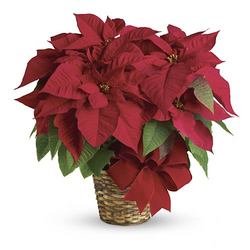Also referred to as Christmas Stars, the Poinsettia originated in Mexico before it became popular in American Christmas traditions. Dr. Joel Roberts Poinsett, the U.S. ambassador to Mexico and amateur botanist, introduced the Poinsettia to the United States in 1928. The bright red, pink, or white colors of the Poinsettia, which are perceived as the petals of the flower, are really leaves called bracts. The actual flowers are small, yellow clusters of balls in between those brilliant bracts. This plant is sold in pots during the holiday season, yet with special attention, the Poinsettia can grow to enormous sizes. This plant is known as a short day plant because it grows best when the nights are long and the days are short. It was once thought that the Poinsettia is a poisonous threat to pets and small children. There is no evidence that the Poinsettia is a hazard. However, eating large amounts of the plant will cause upset in the digestive system.
A story passed down through the centuries illustrates how the Poinsettia became a part of Christmas tradition. Gifts used to be left at the altar for Jesus on Christmas Eve. Yet, one Christmas Eve, a poor boy had no gift for Jesus. He knelt at the altar to pray and when he left, a Poinsettia bloomed where he knelt. This is how the Poinsettia became known as Fleur de Bueno Noche in Mexico, or the Flower of the Holy Night. This flower is also referred to as the Nativity Flower because the altar is often decorated in Poinsettias during the holiday season.
For more information about the Poinsttia, please visit our Poinsettia FAQ.




